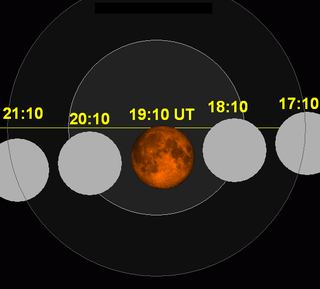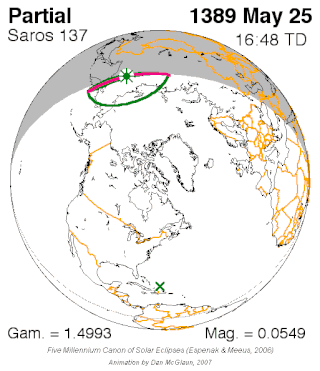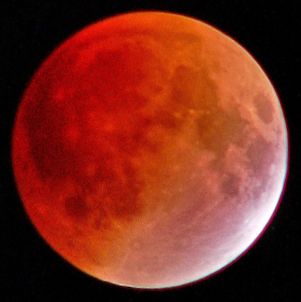| member 26 |
|---|
 2015 Sep 28 |
Saros cycle series 137 for lunar eclipses occurs at the moon's descending node, repeats every 18 years 11 and 1/3 days. It contains 78 events. [1]
Contents
| Cat. | Saros | Mem | Date | Time UT (hr:mn) | Type | Gamma | Magnitude | Duration (min) | Contacts UT (hr:mn) | Chart | |||||||
|---|---|---|---|---|---|---|---|---|---|---|---|---|---|---|---|---|---|
| Greatest | Pen. | Par. | Tot. | P1 | P4 | U1 | U2 | U3 | U4 | ||||||||
| 08582 | 137 | 1 | 1564 Dec 17 | 21:16:37 | Penumbral | -1.5587 | -1.0109 | 23.0 | 21:05:07 | 21:28:07 | |||||||
| 08625 | 137 | 2 | 1583 Jan 08 | 5:55:04 | Penumbral | -1.5513 | -0.9958 | 38.4 | 5:35:52 | 6:14:16 | |||||||
| 08668 | 137 | 3 | 1601 Jan 18 | 14:32:25 | Penumbral | -1.5425 | -0.9777 | 50.9 | 14:06:58 | 14:57:52 | |||||||
| 08713 | 137 | 4 | 1619 Jan 29 | 23:07:09 | Penumbral | -1.5311 | -0.9547 | 63.5 | 22:35:24 | 23:38:54 | |||||||
| 08757 | 137 | 5 | 1637 Feb 09 | 7:38:45 | Penumbral | -1.5164 | -0.9256 | 76.7 | 7:00:24 | 8:17:06 | |||||||
| 08801 | 137 | 6 | 1655 Feb 20 | 16:03:56 | Penumbral | -1.4962 | -0.8860 | 91.8 | 15:18:02 | 16:49:50 | |||||||
| 08846 | 137 | 7 | 1673 Mar 03 | 0:24:02 | Penumbral | -1.4715 | -0.8381 | 107.2 | 23:30:26 | 1:17:38 | |||||||
| 08892 | 137 | 8 | 1691 Mar 14 | 8:36:44 | Penumbral | -1.4403 | -0.7780 | 123.8 | 7:34:50 | 9:38:38 | |||||||
| 08938 | 137 | 9 | 1709 Mar 25 | 16:43:34 | Penumbral | -1.4038 | -0.7084 | 140.3 | 15:33:25 | 17:53:43 | |||||||
| 08985 | 137 | 10 | 1727 Apr 06 | 0:41:54 | Penumbral | -1.3596 | -0.6247 | 157.4 | 23:23:12 | 2:00:36 | |||||||
| 09031 | 137 | 11 | 1745 Apr 16 | 8:34:55 | Penumbral | -1.3106 | -0.5321 | 173.9 | 7:07:58 | 10:01:52 | |||||||
| 09078 | 137 | 12 | 1763 Apr 27 | 16:20:38 | Penumbral | -1.2552 | -0.4281 | 190.1 | 14:45:35 | 17:55:41 | |||||||
| 09124 | 137 | 13 | 1781 May 8 | 0:01:08 | Penumbral | -1.1949 | -0.3152 | 205.6 | 22:18:20 | 1:43:56 | |||||||
| 09169 | 137 | 14 | 1799 May 19 | 7:36:00 | Penumbral | -1.1294 | -0.1930 | 220.3 | 5:45:51 | 9:26:09 | |||||||
| 09214 | 137 | 15 | 1817 May 30 | 15:07:30 | Penumbral | -1.0607 | -0.0652 | 233.9 | 13:10:33 | 17:04:27 | |||||||
| 09260 | 137 | 16 | 1835 Jun 10 | 22:35:53 | Partial | -0.9888 | 0.0681 | 246.4 | 56.8 | 20:32:41 | 0:39:05 | 22:07:29 | 23:04:17 | ||||
| 09306 | 137 | 17 | 1853 Jun 21 | 6:01:48 | Partial | -0.9146 | 0.2056 | 257.8 | 96.7 | 3:52:54 | 8:10:42 | 5:13:27 | 6:50:09 | ||||
| 09350 | 137 | 18 | 1871 Jul 02 | 13:27:48 | Partial | -0.8401 | 0.3432 | 267.9 | 122.4 | 11:13:51 | 15:41:45 | 12:26:36 | 14:29:00 | ||||
| 09393 | 137 | 19 | 1889 Jul 12 | 20:53:52 | Partial | -0.7654 | 0.4807 | 276.8 | 141.7 | 18:35:28 | 23:12:16 | 19:43:01 | 22:04:43 | ||||
| 09436 | 137 | 20 | 1907 Jul 25 | 4:22:27 | Partial | -0.6924 | 0.6149 | 284.5 | 156.8 | 2:00:12 | 6:44:42 | 3:04:03 | 5:40:51 | ||||
| 09478 | 137 | 21 | 1925 Aug 04 | 11:52:57 | Partial | -0.6208 | 0.7463 | 291.2 | 168.9 | 9:27:21 | 14:18:33 | 10:28:30 | 13:17:24 | ||||
| 09520 | 137 | 22 | 1943 Aug 15 | 19:28:46 | Partial | -0.5533 | 0.8697 | 296.7 | 178.4 | 17:00:25 | 21:57:07 | 17:59:34 | 20:57:58 | ||||
| 09561 | 137 | 23 | 1961 Aug 26 | 3:08:51 | Partial | -0.4894 | 0.9863 | 301.4 | 186.0 | 0:38:09 | 5:39:33 | 1:35:51 | 4:41:51 | ||||
| 09602 | 137 | 24 | 1979 Sep 06 | 10:55:02 | Total | -0.4305 | 1.0936 | 305.1 | 191.9 | 44.4 | 8:22:29 | 13:27:35 | 9:19:05 | 10:32:50 | 11:17:14 | 12:30:59 | |
| 09643 | 137 | 25 | 1997 Sep 16 | 18:47:42 | Total | -0.3768 | 1.1909 | 308.2 | 196.4 | 61.5 | 16:13:36 | 21:21:48 | 17:09:30 | 18:16:57 | 19:18:27 | 20:25:54 | |
| 09685 | 137 | 26 | 2015 Sep 28 | 2:48:17 | Total | -0.3296 | 1.2764 | 310.7 | 199.9 | 71.9 | 0:12:56 | 5:23:38 | 1:08:20 | 2:12:20 | 3:24:14 | 4:28:14 | |
| 09726 | 137 | 27 | 2033 Oct 08 | 10:56:23 | Total | -0.2889 | 1.3497 | 312.6 | 202.4 | 78.8 | 8:20:05 | 13:32:41 | 9:15:11 | 10:16:59 | 11:35:47 | 12:37:35 | |
| 09766 | 137 | 28 | 2051 Oct 19 | 19:11:50 | Total | -0.2542 | 1.4118 | 314.2 | 204.3 | 83.6 | 16:34:44 | 21:48:56 | 17:29:41 | 18:30:02 | 19:53:38 | 20:53:59 | |
| 09807 | 137 | 29 | 2069 Oct 30 | 3:35:06 | Total | -0.2263 | 1.4616 | 315.4 | 205.6 | 86.8 | 0:57:24 | 6:12:48 | 1:52:18 | 2:51:42 | 4:18:30 | 5:17:54 | |
| 09848 | 137 | 30 | 2087 Nov 10 | 12:05:33 | Total | -0.2043 | 1.5006 | 316.4 | 206.6 | 88.9 | 9:27:21 | 14:43:45 | 10:22:15 | 11:21:06 | 12:50:00 | 13:48:51 | |
| 09890 | 137 | 31 | 2105 Nov 21 | 20:42:00 | Total | -0.1874 | 1.5301 | 317.3 | 207.3 | 90.4 | 18:03:21 | 23:20:39 | 18:58:21 | 19:56:48 | 21:27:12 | 22:25:39 | |
| 09932 | 137 | 32 | 2123 Dec 03 | 5:24:09 | Total | -0.1755 | 1.5507 | 318.0 | 207.7 | 91.4 | 2:45:09 | 8:03:09 | 3:40:18 | 4:38:27 | 6:09:51 | 7:08:00 | |
| 09975 | 137 | 33 | 2141 Dec 13 | 14:10:16 | Total | -0.1671 | 1.5652 | 318.7 | 208.1 | 92.0 | 11:30:55 | 16:49:37 | 12:26:13 | 13:24:16 | 14:56:16 | 15:54:19 | |
| 10019 | 137 | 34 | 2159 Dec 24 | 23:00:09 | Total | -0.1619 | 1.5737 | 319.2 | 208.4 | 92.4 | 20:20:33 | 1:39:45 | 21:15:57 | 22:13:57 | 23:46:21 | 0:44:21 | |
| 10062 | 137 | 35 | 2178 Jan 04 | 7:50:14 | Total | -0.1570 | 1.5820 | 319.8 | 208.8 | 92.8 | 5:10:20 | 10:30:08 | 6:05:50 | 7:03:50 | 8:36:38 | 9:34:38 | |
| 10105 | 137 | 36 | 2196 Jan 15 | 16:41:55 | Total | -0.1537 | 1.5877 | 320.3 | 209.1 | 93.1 | 14:01:46 | 19:22:04 | 14:57:22 | 15:55:22 | 17:28:28 | 18:26:28 | |
| 10149 | 137 | 37 | 2214 Jan 27 | 1:30:46 | Total | -0.1480 | 1.5979 | 320.9 | 209.5 | 93.6 | 22:50:19 | 4:11:13 | 23:46:01 | 0:43:58 | 2:17:34 | 3:15:31 | |
| 10193 | 137 | 38 | 2232 Feb 07 | 10:17:44 | Total | -0.1410 | 1.6106 | 321.5 | 210.0 | 94.1 | 7:36:59 | 12:58:29 | 8:32:44 | 9:30:41 | 11:04:47 | 12:02:44 | |
| 10239 | 137 | 39 | 2250 Feb 17 | 18:58:32 | Total | -0.1291 | 1.6326 | 322.2 | 210.7 | 95.0 | 16:17:26 | 21:39:38 | 17:13:11 | 18:11:02 | 19:46:02 | 20:43:53 | |
| 10285 | 137 | 40 | 2268 Feb 29 | 3:35:27 | Total | -0.1142 | 1.6602 | 322.9 | 211.4 | 96.0 | 0:54:00 | 6:16:54 | 1:49:45 | 2:47:27 | 4:23:27 | 5:21:09 | |
| 10331 | 137 | 41 | 2286 Mar 11 | 12:04:37 | Total | -0.0929 | 1.6996 | 323.7 | 212.3 | 97.2 | 9:22:46 | 14:46:28 | 10:18:28 | 11:16:01 | 12:53:13 | 13:50:46 | |
| 10377 | 137 | 42 | 2304 Mar 22 | 20:26:42 | Total | -0.0661 | 1.7491 | 324.6 | 213.1 | 98.4 | 17:44:24 | 23:09:00 | 18:40:09 | 19:37:30 | 21:15:54 | 22:13:15 | |
| 10423 | 137 | 43 | 2322 Apr 03 | 4:39:45 | Total | -0.0323 | 1.8116 | 325.4 | 213.9 | 99.4 | 1:57:03 | 7:22:27 | 2:52:48 | 3:50:03 | 5:29:27 | 6:26:42 | |
| 10469 | 137 | 44 | 2340 Apr 13 | 12:45:17 | Total | 0.0074 | 1.8576 | 326.1 | 214.5 | 99.9 | 10:02:14 | 15:28:20 | 10:58:02 | 11:55:20 | 13:35:14 | 14:32:32 | |
| 10514 | 137 | 45 | 2358 Apr 24 | 20:41:46 | Total | 0.0542 | 1.7720 | 326.7 | 214.8 | 99.5 | 17:58:25 | 23:25:07 | 18:54:22 | 19:52:01 | 21:31:31 | 22:29:10 | |
| 10559 | 137 | 46 | 2376 May 5 | 4:29:55 | Total | 0.1074 | 1.6744 | 326.9 | 214.4 | 97.8 | 1:46:28 | 7:13:22 | 2:42:43 | 3:41:01 | 5:18:49 | 6:17:07 | |
| 10603 | 137 | 47 | 2394 May 16 | 12:10:00 | Total | 0.1667 | 1.5656 | 326.6 | 213.3 | 94.3 | 9:26:42 | 14:53:18 | 10:23:21 | 11:22:51 | 12:57:09 | 13:56:39 | |
| 10649 | 137 | 48 | 2412 May 26 | 19:43:25 | Total | 0.2306 | 1.4479 | 325.8 | 211.1 | 88.2 | 17:00:31 | 22:26:19 | 17:57:52 | 18:59:19 | 20:27:31 | 21:28:58 | |
| 10693 | 137 | 49 | 2430 Jun 07 | 3:09:30 | Total | 0.3000 | 1.3201 | 324.3 | 207.7 | 78.4 | 0:27:21 | 5:51:39 | 1:25:39 | 2:30:18 | 3:48:42 | 4:53:21 | |
| 10737 | 137 | 50 | 2448 Jun 17 | 10:30:31 | Total | 0.3730 | 1.1854 | 322.0 | 202.8 | 62.6 | 7:49:31 | 13:11:31 | 8:49:07 | 9:59:13 | 11:01:49 | 12:11:55 | |
| 10780 | 137 | 51 | 2466 Jun 28 | 17:46:38 | Total | 0.4490 | 1.0448 | 318.7 | 196.2 | 32.2 | 15:07:17 | 20:25:59 | 16:08:32 | 17:30:32 | 18:02:44 | 19:24:44 | |
| 10822 | 137 | 52 | 2484 Jul 09 | 1:00:42 | Partial | 0.5260 | 0.9021 | 314.5 | 187.6 | 22:23:27 | 3:37:57 | 23:26:54 | 2:34:30 | ||||
| 10863 | 137 | 53 | 2502 Jul 21 | 8:11:07 | Partial | 0.6051 | 0.7554 | 309.2 | 176.6 | 5:36:31 | 10:45:43 | 6:42:49 | 9:39:25 | ||||
| 10904 | 137 | 54 | 2520 Jul 31 | 15:22:37 | Partial | 0.6822 | 0.6120 | 303.0 | 163.3 | 12:51:07 | 17:54:07 | 14:00:58 | 16:44:16 | ||||
| 10944 | 137 | 55 | 2538 Aug 11 | 22:33:32 | Partial | 0.7588 | 0.4693 | 295.7 | 146.7 | 20:05:41 | 1:01:23 | 21:20:11 | 23:46:53 | ||||
| 10986 | 137 | 56 | 2556 Aug 22 | 5:48:05 | Partial | 0.8315 | 0.3334 | 287.8 | 126.6 | 3:24:11 | 8:11:59 | 4:44:47 | 6:51:23 | ||||
| 11027 | 137 | 57 | 2574 Sep 02 | 13:03:42 | Partial | 0.9023 | 0.2008 | 278.9 | 100.5 | 10:44:15 | 15:23:09 | 12:13:27 | 13:53:57 | ||||
| 11067 | 137 | 58 | 2592 Sep 12 | 20:25:19 | Partial | 0.9671 | 0.0791 | 269.7 | 64.3 | 18:10:28 | 22:40:10 | 19:53:10 | 20:57:28 | ||||
| 11107 | 137 | 59 | 2610 Sep 25 | 3:50:47 | Penumbral | 1.0277 | -0.0350 | 260.2 | 1:40:41 | 6:00:53 | |||||||
| 11147 | 137 | 60 | 2628 Oct 05 | 11:22:30 | Penumbral | 1.0821 | -0.1379 | 250.7 | 9:17:09 | 13:27:51 | |||||||
| 11188 | 137 | 61 | 2646 Oct 16 | 19:00:12 | Penumbral | 1.1308 | -0.2304 | 241.4 | 16:59:30 | 21:00:54 | |||||||
| 11230 | 137 | 62 | 2664 Oct 27 | 2:45:20 | Penumbral | 1.1726 | -0.3102 | 232.7 | 0:48:59 | 4:41:41 | |||||||
| 11273 | 137 | 63 | 2682 Nov 07 | 10:37:27 | Penumbral | 1.2077 | -0.3776 | 225.0 | 8:44:57 | 12:29:57 | |||||||
| 11315 | 137 | 64 | 2700 Nov 18 | 18:35:06 | Penumbral | 1.2375 | -0.4352 | 218.0 | 16:46:06 | 20:24:06 | |||||||
| 11358 | 137 | 65 | 2718 Nov 30 | 2:39:40 | Penumbral | 1.2608 | -0.4808 | 212.5 | 0:53:25 | 4:25:55 | |||||||
| 11400 | 137 | 66 | 2736 Dec 10 | 10:49:08 | Penumbral | 1.2799 | -0.5183 | 207.8 | 9:05:14 | 12:33:02 | |||||||
| 11443 | 137 | 67 | 2754 Dec 21 | 19:03:15 | Penumbral | 1.2944 | -0.5472 | 204.3 | 17:21:06 | 20:45:24 | |||||||
| 11487 | 137 | 68 | 2773 Jan 01 | 3:19:29 | Penumbral | 1.3067 | -0.5717 | 201.3 | 1:38:50 | 5:00:08 | |||||||
| 11532 | 137 | 69 | 2791 Jan 12 | 11:38:09 | Penumbral | 1.3165 | -0.5914 | 198.9 | 9:58:42 | 13:17:36 | |||||||
| 11578 | 137 | 70 | 2809 Jan 22 | 19:56:13 | Penumbral | 1.3263 | -0.6107 | 196.3 | 18:18:04 | 21:34:22 | |||||||
| 11625 | 137 | 71 | 2827 Feb 03 | 4:12:29 | Penumbral | 1.3371 | -0.6314 | 193.2 | 2:35:53 | 5:49:05 | |||||||
| 11672 | 137 | 72 | 2845 Feb 13 | 12:25:13 | Penumbral | 1.3502 | -0.6561 | 188.9 | 10:50:46 | 13:59:40 | |||||||
| 11718 | 137 | 73 | 2863 Feb 24 | 20:33:14 | Penumbral | 1.3665 | -0.6864 | 183.1 | 19:01:41 | 22:04:47 | |||||||
| 11764 | 137 | 74 | 2881 Mar 07 | 4:34:07 | Penumbral | 1.3878 | -0.7256 | 174.7 | 3:06:46 | 6:01:28 | |||||||
| 11810 | 137 | 75 | 2899 Mar 18 | 12:27:24 | Penumbral | 1.4146 | -0.7748 | 163.0 | 11:05:54 | 13:48:54 | |||||||
| 11855 | 137 | 76 | 2917 Mar 29 | 20:11:52 | Penumbral | 1.4477 | -0.8350 | 146.6 | 18:58:34 | 21:25:10 | |||||||
| 11900 | 137 | 77 | 2935 Apr 10 | 3:47:50 | Penumbral | 1.4869 | -0.9066 | 123.4 | 2:46:08 | 4:49:32 | |||||||
| 11945 | 137 | 78 | 2953 Apr 20 | 11:12:26 | Penumbral | 1.5341 | -0.9928 | 86.0 | 10:29:26 | 11:55:26 | |||||||


















